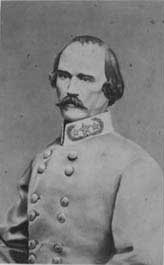| ||||||||||||||||||||||||||||||||||||
Albert Sidney Johnston (February 2, 1803 – April 6, 1862) was a career United States Army officer, a Texas Army general, and a Confederate States Army general. He saw extensive combat during his military career, fighting actions in the Texas War of Independence, the Mexican-American War, the Utah War of 1857 (putting down an uprising by the Mormon/LDS Church), as well as the American Civil War. He also served a stint as Secretary of War in the short-lived Republic of Texas.
Considered by CS President Jefferson Davis to be the finest general officer in the Confederacy before the emergence of Robert E. Lee, Johnston was killed early in the Civil War at the Battle of Shiloh and was the highest ranking officer, Union or Confederate, killed during the entire war.
Albert Sidney Johnston in Southern Victory[]
Albert Sidney Johnston joined the Confederate Army, when the War of Secession began in 1861. He was given command of all Confederate forces in the west. Johnston was at the Battle of Shiloh, the war's bloodiest battle, where he was killed in the fighting.
After the war, Johnston went down in Confederate history as a martyr. Statues of Johnston were erected throughout the country, including on the National Square in Richmond.[1] Despite being surrounded by sandbags, that statue was destroyed in 1943, during the last phase of the Second Great War. A nearby statue of George Washington, who was well-regarded by both nations, survived.[2] Workmen hauled the remains of Johnston's statue away for scrap after the war.[3]
See also[]
- Sidney the War Unicorn, an analog of Johnson in The War Between the Provinces.
References[]
- ↑ American Front, pg. 30, HC.
- ↑ In at the Death, pg. 108.
- ↑ Ibid., pg. 602.
| Political offices (OTL) | ||
|---|---|---|
| Preceded by Barnard E. Bee, Sr. |
Secretary of War for the Republic of Texas 1838-1840 |
Succeeded by Branch T. Archer |
| Military offices (Southern Victory) | ||
| Preceded by None |
Military Governor of Utah 1858 |
Succeeded by A Period of Vacancy, then John Pope |











